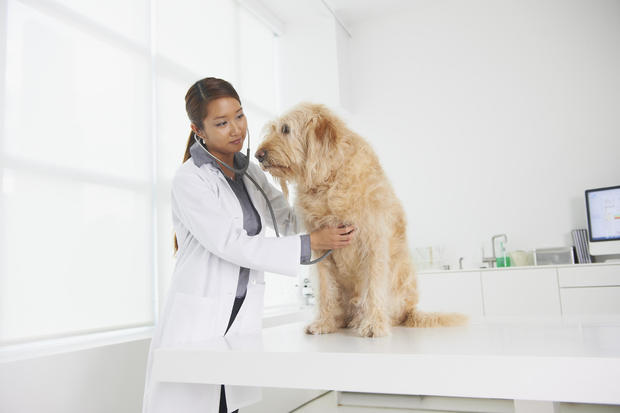How to get the best pet insurance according to vets
The only thing worse than your furry family member sustaining a severe injury or illness is being unable to pay for the treatment they need to recover. In such circumstances, pet insurance can be beneficial for covering qualified medical expenses in exchange for paying a monthly premium.
With spring upon us, warmer weather and increased outdoor activity for pets can raise the risk of injury. Consequently, many pet owners are contemplating getting pet insurance.
If you're looking into pet insurance, remember the cost of premiums is important, but several other considerations should also factor into your decision.
If you're in the market for pet insurance then start by getting a free price quote so you know what to expect.
What vets say you should do to get the best pet insurance
The process of getting pet insurance is fast and straightforward. These essential tips from veterinarians can help to ensure you get the best policy for your pet.
Get coverage early
"Pet parents should get their fur babies covered as early in life as possible, ideally starting when they're young with a clean bill of health," says Dr. Rebecca Greenstein, veterinary medical advisor for Rover. "Many policies have exclusions for pre-existing conditions, so if you're looking to obtain coverage in the midst of an active health concern, insurance likely won't cover the current problem."
"The earlier they get covered, the wider their coverage possibilities," adds Dr. Paola Cuevas, veterinary consultant at Petkeen. But Cuevas cautions that if your pet is already diagnosed with a disease, pet insurance may not be your best option since it won't cover the pre-existing condition.
You can learn more by getting a free price quote from Spot pet insurance now.
Understand the policy
When you get an insurance quote, price is a primary concern, but understand that your monthly premiums can vary depending on a number of factors, such as:
- Deductible: The deductible is the amount you must pay out of pocket before your pet insurance coverage kicks in. Deductibles range from $100 to $1,000, and usually, lower deductibles come with higher monthly premiums.
- Reimbursement percentage: This percentage refers to the covered expenses the insurance company will reimburse to the policyholder. Reimbursement percentages typically range from 70% to 90%.
- Annual coverage limit: Keep in mind, you can set the annual coverage limit that your pet insurer will pay for covered expenses. Annual coverage limits range from $2,500 to $100,000, with some policies offering unlimited coverage.
Generally, the lower your deductible, coverage amount and reimbursement percentage, the lower your monthly premiums.
Before you agree, read the terms and conditions to understand any specific circumstances that can affect your coverage and ask questions if necessary.
"Two very important questions to ask are: Is your deductible per year or per lifetime of the pet? And is the deductible per problem or per pet?" advises Dr. Sarah Gorman, DVM, CCRP, managing vet at Small Door Veterinary Newton Centre practice.
Shop and compare policies
Getting quotes from multiple pet insurance companies is a good strategy for finding the most comprehensive coverage at an affordable price. Pet insurance companies usually provide price quotes based on the coverage options listed in the previous section, and your pet's breed, age and health.
"Shop around," says Greenstein. "It's a pretty competitive landscape these days, and different companies have different pricing for different breeds and a range of coverages to choose from."
Dr. Randall Cannon, DVM and resident veterinarian on the goodcounsl app, stresses the importance of making sure a pet insurance company has a good track record of paying out claims. "When shopping around for pet insurance, it's best to rely on word of mouth from real people who have successfully made substantial claims."
While the pricing you receive will depend on numerous factors, including your pet's breed, here's a general idea of what some pet insurance companies are quoting. The following sample quotes are for a 5-year-old mixed dog, medium weight, in good health in Boulder, Colorado. Coverage options include a $500 deductible, 80% reimbursement percentage and the maximum coverage option.
Insurer | Cost | Annual deductible options | Reimbursement percentage | Coverage amounts |
Lemonade | $39 per month | $100, $250, $500 | 70%, 80%, 90% | $5,000 to $100,000 |
Odie | $22.42 per month | $50 to $1,000 | 70%, 80%, 90% | $5,000, $10,000, $40,000 |
AKC | $36.93 per month | $100 to $1,000 | 70%, 80%, 90% | $2,500 to unlimited |
Spot | $92.21 | $100 to $1,000 | 70%, 80%, 90% | $2,500 to unlimited |
HealthyPaws | $48.42 | $250, $500, $750, $1,000 | 50%, 60, 70%, 80% | No maximum limits |
Embrace | $93 per month | $100, $250, $500, $750, $1,000 | 70%, 80%, 90% | $5,000 to Unlimited |
ManyPets | $28 per month | $250, $500, $750 | 70%, 80%, 90% | Unlimited |
The cheapest policy may be the most affordable, but review the terms of the policy to ensure the coverage meets your needs.
The opposite is also true. "Don't assume that the most expensive insurance is the best," says Gorman. "This is not always the case. This is a competitive, growing market; sometimes the newer companies have more affordable rates."
Shop your pet insurance options by getting a free price quote here or by using the below table.
What vets say you shouldn't do to get the best pet insurance
When searching for the best pet insurance policy, it's important to avoid common pitfalls that could lead to poor decisions. Here are some mistakes to avoid:
Don't underinsure
"Pet owners often wrongly assume that pet insurance will cover absolutely everything," says Greenstein. "Always read the fine print on your policy and ask a lot of questions."
The most affordable coverage is usually found with accident-only policies that cover broken bones, lacerations and poisoning. For broader coverage, an accident and illness plan covers many accidental injuries and treatments for conditions ranging from allergies and hereditary conditions to cancer and diabetes.
Being underinsured is often the result of purchasing the most inexpensive policy. "Pet owners should not buy the cheapest policy without analyzing it first," says Cuevas. "Sometimes it is worth spending the extra cash on add-ons such as dental care. Add in the wellness plan, which will normally cover vaccinations, deworming and preventative medicine."
Don't skip over the fine print
What's the biggest mistake pet owners make when purchasing vet insurance? "Not reading the coverage closely," says Gorman. "For example, dental disease is the number one disease in our pet population. Dental procedures with surgical extractions are considered wellness care and are not covered by most insurance unless there is a traumatic injury to the mouth. These procedures can be quite costly."
Reading the fine print can help to ensure there are no surprises when it's time to make a claim. "Most insurance companies spell out the different ways they'll avoid paying, such as citing pre-existing conditions or genetics," says Cannon.
The bottom line
If you read the fine print and are sure a pet insurance policy can protect you against a substantial and unexpected vet bill, consider getting your pet covered long-term. "A lot of pet owners will ask me if they should cancel their policies if they've paid in for years and have never made a claim," says Greenstein. "The answer is a resounding 'no!' Statistically, the number of health insurance claims is only going to go up for elderly pets, so ending a policy when a pet is older is often a terrible idea."




